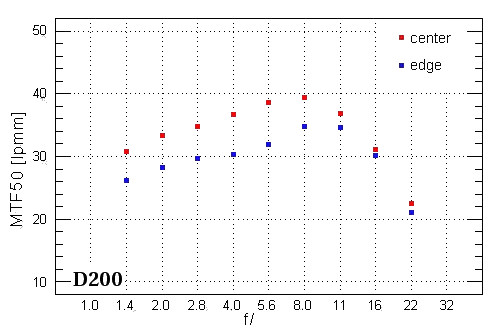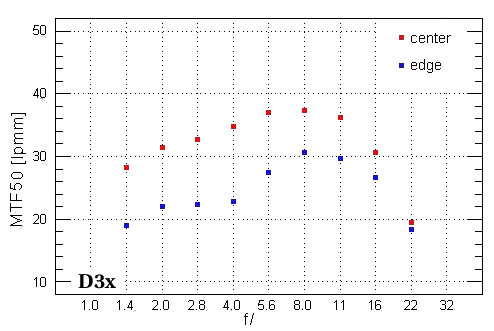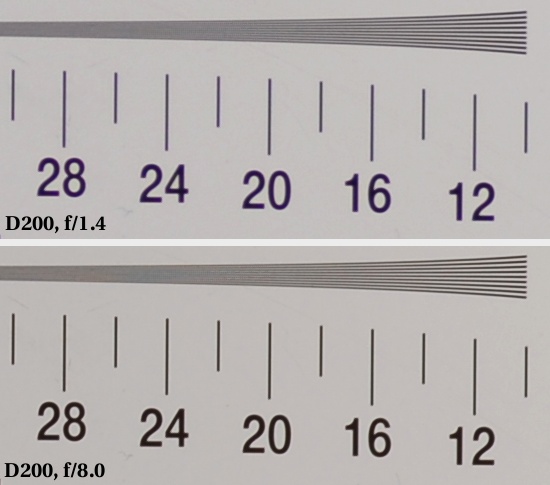Samyang 85 mm f/1.4 Aspherical IF
4. Image resolution
Points of error shown on the graph range from 1.7 lpmm in the region of maximum aperture to 0.2 lpmm at minimal aperture.
Let’s beging with the results obtained with the Nikon D200. This will enable us to easily compare the achievements of the Samyang with that of the Nikorr 1.8/85 tested on the same body and the Sony 1.4/85 tested on the A100 (which also as a 10-megapixel matrix from the same manufacturer). Notably, the Samyang in no way loses out in this comparison. Let’s look at the graph below:
Please Support UsIf you enjoy our reviews and articles, and you want us to continue our work please, support our website by donating through PayPal. The funds are going to be used for paying our editorial team, renting servers, and equipping our testing studio; only that way we will be able to continue providing you interesting content for free. |
- - - - - - - - - - - - - - - - - - - - - - - - - - - - - - - - - - - - - - - - - - - - - - - -

Depending on the degree of aperture, the course of the MTF50 is very interesting. Good news to start with: the image at maximum aperture is fully usable since the obtained resolution slightly exceeds 30 lpmm. This result surpasses both the Nikkor and the Zeiss, whose images at maximum aperture were very ‘soft’.
However, later on we observe behavior quite different from the majority of fast fixed focal lenght lenses. Typically we can observe a rapid sharpening of resolution as the aperture narrows, producing a very high maximum for f/4.0-5.6. Samyang behaves quite differently. The quality of image improves slowly with closing, reaching a rather low maximum at f/8.0, Overall the maximum MTFs of the Samyang are average at best, not even achieving 40 lpmm, while the sharpest primes tested on the D200 were able to reach a value of around 47 lpmm. In effect, at apertures above f/2.8, rival lenses are significantly sharper.
Behavior at the edge of the frame immitates that observed at mid-frame, except that the values are a good few lpmm lower. To achieve reasonably sharp edges on the DX matrix, the Samyang must be stopped to around f/2.8- 4.0, as only then do we get a value of 30 lpmm. The Nikkor 1.8/85 is again very ‘soft’ at full aperture, reaching 30 lpmm at around f/2.8, although it then climbs to a value which for the Samyang is unattainable even at center of the frame! The Sony at full aperture comes close to the Samyang, but at just f/2.0 is noticeably sharper, achieving 30 lpmm.
To sum up, it seems that the makers of the Samyang focused on producing a lens that gives a fully usable image at maximum aperture. But in order to do so, they sacrificed the high resolution at an aperture range of f/4.0-8.0, as well as taking less care of image resolution at the edge of the frame.
What does the situation look like at full-frame? Lets look at the following graph:

The situation in the center is similar to what we saw on the D200. This comes as no surprise, for, as we mentioned, both cameras have a similar pixel density. However, individual D3x pixels don’t perform as well as those of the D200, thus the MTFs shown in lpmm obtained from the D3x are around 2 lpmm lower than those of the D200. This can be clearly seen on the graph.
However the edge of the frame is another matter. The full frame dimensions are 1.5 times greater than the DX matrix format, and thus the edge of the frame makes more demands on any lens. And the Samyang has difficulty meeting these demands. Only at an aperture of f/8.0 do we achieve a value of 30 lpmm and then only at apertures close to this can we say that the edges of the frame are anywhere near sharp. Unfortunately, we don’t yet know how to accurately judge the behavior of the Samyang. As yet we have too few materials and to few full-frame lens tests to see the full range of behavior and thus give a deciding verdict.
 |






